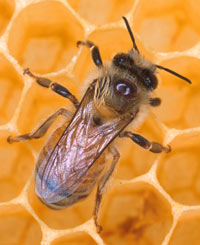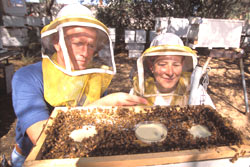| Maryland Newsline |
| Home Page |
Politics
|
Beekeepers,
Researchers Fight to Keep Maryland's Best Pollinators
Buzzing
By Lisa D. Tossey If your garden has been a little quieter the last few springtimes, there’s good reason. Maryland’s honeybees have been decimated by parasitic mites over the last 15 years, pushing beekeepers and researchers to find ways to keep the bees buzzing and raising questions about the possible regulation of genetically modified bees and their honey. Bee colonies in Maryland have suffered huge die-offs as a result of the invasion of two parasites, the tracheal mite (Acarapis woodi) and the ominous sounding Varroa destructor mite, said Jay Evans, a research entomologist at the U.S. Department of Agriculture’s Bee Research Laboratory. Of the two mites, Varroa, which feeds on the blood of developing larvae and adult bees, has been the more destructive. “It lives on a bee like a tick on a dog,” said Jerry Fischer, state apiary inspector for the Maryland Department of Agriculture. The mite’s feeding habits weaken the bees, leaving them susceptible to infections and disease, he said. Evans and other scientists at the Bee Research Laboratory in Beltsville, Md., have been examining the biology of such honeybee parasites, diseases and pests to develop biological, chemical and nonchemical methods of control. In early January the researchers were given a vital new tool: A team of U.S. scientists completed a draft of the honeybee genome and posted the sequence in an online database. It was the first genome of a domesticated animal to be completed. Evans said having the genetic sequence available as a research tool will be helpful, allowing scientists to test the importance and function of a single gene by “silencing it.” He expects researchers will largely use the genome to influence breeding programs and says although he isn’t aware of any current work, the creation of genetically modified bees might be a possibility in the future. A recent report from the Pew Initiative on Food and Biotechnology titled “Bugs in the System?” states that there may be public health and agricultural benefits from genetically modified insects, but warns that clear oversight by the government is lacking. “The $64,000 question is, 'Who will regulate?' ” said Dan DiFonzo, deputy director of media relations for the initiative. “The government agencies need to get together to sort it out. We’re trying to jump-start the debate.” The Importance of Bees Bees are agricultural workhorses. The U.S. Department of Agriculture estimates that 80 percent of crop pollination by insects is accomplished by honeybees. In Maryland, the bumbling aviators are responsible each year for pollinating crops valued at more than $40 million, Fischer said. This makes them invaluable to area farmers, who have relied on wild swarms to pollinate their crops since the bees were first imported from Europe nearly 400 years ago. “Farmers would walk the fields and keep count of how many bees they saw in 25 steps,” Fischer said. “Then 12 years ago, our office received many calls asking, ‘Where are the bees?’ ” The Spread of Pests Evans said the mites spread throughout the country almost overnight and have “effectively erased the genetic population of wild bees.” He estimates that less than 10 percent of the wild U.S. bee population remains.
At the peak of the outbreak, Maryland lost nearly 99 percent of its feral colonies, Fischer said. Farmers were forced to turn to beekeepers for help, renting domesticated colonies to pollinate their crops and orchards. Fischer, who oversees the nearly 1,000 beekeepers registered in Maryland, said roughly 4,500 colonies are rented out to agriculture each year. Because of different growing seasons for the state’s diverse crops, such as apples, pears, cucumbers, melons and pumpkins, each colony serves about five different “contract pollinations” a year. So far, these domestic populations have been somewhat protected through the keepers' use of mite screens and miticides, and by researchers' development of disease-resistant strains of bees. “Keepers have managed to keep the bees going at some level,” says Evans. But those domestic colonies have been hit hard as well. Davis Morris, past president of the Maryland State Beekeepers Association, said the introduction of mites caused beekeepers to lose 50 percent to 60 percent of their hives between 1995 and 1996 – a loss he says they haven’t fully recovered from. In the past two decades, the number of managed hives statewide has dropped from about 25,000 to 10,000. “It’s been difficult,” said Morris, who keeps bees as a hobby and now serves as president of the Bowie-Upper Marlboro Beekeepers Association. “It’s very difficult to just keep a hive alive without chemical treatment.” Hope for the Future For now, all are cautiously optimistic about the future of Maryland’s bees, noting that there are several strong research programs in the country that are devoted to honeybee survival. In addition, Fischer has seen mite levels drop in Maryland over the past five years. “They’ve been a major problem, but are getting better,” he said. Although he can’t pinpoint exactly why mite populations have declined, Fischer points out that they're unlikely to kill off all the bees. “Fortunately, parasites need a host," he said. "No parasite has ever eliminated its host, because if it does, it also dies." Copyright © 2004 University of Maryland Philip Merrill College of Journalism
|


